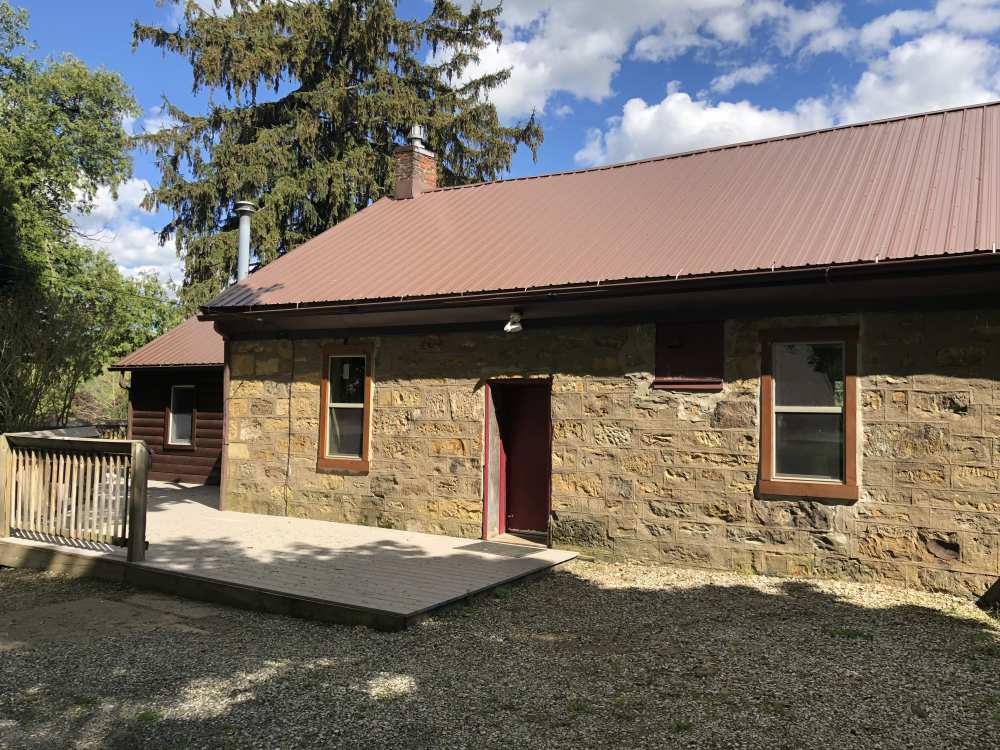For many years, the sandstone residence, now known as the Century House, was owned by the Fuller family (and the entire property thus was called the “Fuller Farm”). A genealogy of the Pells, a branch of the Fuller family, contains most of the recorded early history of the structure and the property.
According to the Pell genealogy, compiled around 1970, the first owner of the land on which the residence stands was Calvin Hibbard, who came to Hanover Township from, ironically, Hanover Township in Pennsylvania sometime around 1820. Mr. Hibbard may have received a land grant through his service in the War of 1812. Accompanying Mr. Hibbard was his mother and two young & recently orphaned nephews, named Calvin and Gilbert Pell.
In 1837, Gilbert Pell, then 33 years of age, married Catherine Fuller, the daughter of Dr. E.B. Fuller, who came to Loudonville from Tioga County, Pennsylvania in 1831. After Gilbert Pell’s untimely death in 1850, Catherine married Calvin Hibbard, thus firmly establishing the Fuller connection with the property. The second son (and third child) of Gilbert and Catherine Pell, Josiah Calvin Pell, later became a doctor, practicing in Loudonville. According to Pell genealogy, Josiah owned the original Hibbard homestead, known as the Old Stone House. The Old Stone House was originally a tavern, and was (and still is) one of the oldest landmarks in the area. The genealogy goes on to say that the House was built before 1820.
However, there is reason to question if the House was built before 1820. The first pioneers did not come to this area until after 1810–and for the next decade or so, very few people lived in Hanover Township. According to Knapp’s 1863 History of Ashland County, only 15 people cast a ballot in Hanover Township’s first election in 1818. Also, Hill’s 1880 History of Ashland County notes that in 1825, there were only 30 people residing in Hanover Township, among them Calvin Hibbard and Gilbert Pell. Finally, Knapp’s work includes a brief biography on Mark Mapes, which says that in 1822, when Mapes cleared and built on land a mile or so south of the Hibbards, they were Mapes’ closest neighbors–the rest were four or five miles away.
With so few people around, it’s easy to wonder how they could have constructed such a large house from heavy pieces of sandstone that somehow had to be moved from a quarry to the construction site. Equipment (and know-how) needed for moving and hoisting the stone would not like have been available in the area until the railroad was built through Loudonville in the early 1850s. However, the house could have been built before then by itinerant stonemasons. With there being no comparable surviving structures (dwellings or otherwise) in the area, there is simply no reference point for estimating when the building was put up.
State Route 3–the road that the Century House and Mohican Adventures is on–for the most part follows the “old stage route” between Columbus and Cleveland, so it would seem reasonable that the old house once saw duty as a tavern, or even a wayside inn. Unfortunately, there is no record as to when the “old stage route” was established–probably not until the 1830s or perhaps later.
An 1874 Hanover Township plat map included in Caldwell’s Atlas of Ashland County lists Calvin Hibbard as the owner of the farm on which the house stands, while an 1898 plat map shows A.B. Fuller (son of E.B. Fuller, and also a doctor) as the owner. An interesting travelogue, penned several years earlier, in Baughman’s 1909 History of Ashland County says “this ancient landmark, The Old Stone House, was owned in succession by two of Loudonville’s eminent physicians, Doctors J.C. Pell and A.B. Fuller”, and at the time was the residence of Mr. and Mrs. Frank Whisler. The author tells of stopping at a stone spring in front of the house for a drink of water.
A.B. Fuller’s son, Gaillard, who also became a doctor practicing in Loudonville, owned the property in the 1930s and 1940s, probably having inherited it from his father. Because of their profession, it is doubtful that any of the Fullers actually made the house their full-time residence. Most likely, they rented it to tenant farmers on the land.
There is some evidence that the House served as a stop on the “Underground Railroad”. In Hill’s 1880 biography on E.B. Fuller, he says “[Fuller] was bitterly opposed to the fugitive slave law. In 1856, two fugitives came to his house early in the morning. He fed them and sent them to Robert Wilson (near Widowville), where they were cared for and taken beyond the reach of the United States marshals and bloodhounds.” A lengthy circa-1960 newspaper piece on the Underground Railroad also lists the House.
The name “Century House” is believed to have been started in the early 1950s by a man named Ziegler (father of current Loudonville resident Larry Ziegler), who opened a restaurant in the house and called it “The Century House”. A guest of Mohican Adventures once stopped by to chat about the House. She worked there when the House was a restaurant, and remembers stories of a family physician that had a sick daughter who died in the House. She said that the Century House will always have a presence that no other house can offer.
It is not known if Dr. Gaillard Fuller still owned the property at the time of his death in the mid-1950s. If so, it may have been sold at that time, or possibly his widow retained ownership until her death in 1973. Robert D. Thompson eventually (1960s?) acquired the whole farm, possibly from the Fuller estate. R.D. Thompson’s vision was to develop the property into a large RV park. He passed away before the park could be opened.
Doug and Patty Shannon acquired the property from the estate in 1998. With the help of their daughter and son-in-law Michelle & Josh Gray, they have since developed a full adventure park. Mohican Adventures has 44 cabins on its property ranging from smaller camper cabins, full-service cabins, and houses that sleep 16 people. The Century House is one of these houses, and is a family favorite for many of our guests. In addition to the cabins, Mohican Adventures now has approximately 200 RV sites, 200 primitive tent sites, 3 mini golf courses, 3 go-kart tracks, an aerial adventure park, and was the first canoe livery in Ohio.

